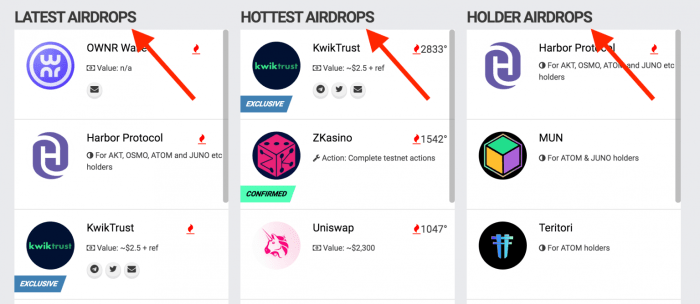Best legit websites for claiming Bitcoin airdrops are increasingly sought after as the cryptocurrency landscape expands. Navigating this space, however, requires caution. This guide provides crucial insights into identifying legitimate platforms, understanding airdrop mechanics, and assessing the inherent risks and potential rewards. We delve into the process of safely participating in airdrops, emphasizing security best practices to protect against scams and maximize your chances of success.
The cryptocurrency market is rife with opportunities, but also dangers. Understanding the nuances of Bitcoin airdrops, from recognizing fraudulent schemes to leveraging legitimate platforms, is critical for any investor seeking to capitalize on this emerging trend. This article equips readers with the knowledge and tools necessary to navigate this complex landscape safely and effectively.
Identifying Legitimate Bitcoin Airdrop Websites

Navigating the world of Bitcoin airdrops requires caution, as many fraudulent schemes exist alongside legitimate opportunities. Understanding how to distinguish between the two is crucial to protect your digital assets and avoid scams. This analysis provides criteria for evaluating the legitimacy of airdrop websites and highlights common red flags to watch out for.
Several key factors contribute to determining the legitimacy of a Bitcoin airdrop website. A comprehensive assessment should encompass website age, security protocols, team transparency, and community engagement. A thorough investigation across these areas can significantly reduce the risk of encountering fraudulent activities.
Website Age and Security Measures
Established websites, operating for a considerable period, often indicate a higher level of trustworthiness. New websites, especially those lacking robust security measures like HTTPS encryption, should be treated with extreme caution. Legitimate airdrop websites prioritize user security by employing encryption and secure server infrastructure to protect user data from unauthorized access. The presence of a clearly displayed privacy policy outlining data handling practices is another positive indicator.
Conversely, the absence of HTTPS or a vague privacy policy is a significant red flag.
Team Transparency and Community Engagement
Transparency regarding the team behind the airdrop project is essential. Legitimate projects typically provide information about their team members, their experience, and their contact details. A lack of such information should raise immediate suspicion. Furthermore, active community engagement, through forums, social media, and dedicated communication channels, is a hallmark of genuine projects. A vibrant and responsive community suggests a commitment to transparency and accountability.
Conversely, a lack of community engagement or unresponsive communication channels may indicate a fraudulent operation.
Red Flags Indicating Fraudulent Airdrop Websites
Several red flags consistently appear in fraudulent airdrop websites. These include unrealistic promises of high returns with minimal effort, requests for excessive personal information, pressure tactics to participate immediately, and the absence of a verifiable whitepaper or detailed project information. Common scams involve phishing attempts, where users are tricked into revealing their private keys or seed phrases, leading to the loss of their Bitcoin.
Other scams involve fake airdrops where users complete tasks, such as social media interactions, only to receive nothing in return.
Comparative Analysis of Bitcoin Airdrop Websites
The following table compares three hypothetical Bitcoin airdrop websites, highlighting their features, potential risks, and community feedback. Note that these are hypothetical examples for illustrative purposes and do not represent actual websites.
| Website Name | Key Features | Risk Assessment | Community Feedback |
|---|---|---|---|
| AirdropAlpha | Established website, HTTPS secured, transparent team, active community forum | Low | Mostly positive, some minor complaints about delays |
| CryptoDropExpress | New website, no HTTPS, anonymous team, limited community interaction | High | Mixed reviews, many reports of scams |
| BitcoinAirdropHeaven | Promises unrealistically high returns, requests excessive personal data, aggressive marketing | Very High | Overwhelmingly negative, numerous reports of fraud |
Understanding the Mechanics of Bitcoin Airdrops

Bitcoin airdrops, the free distribution of Bitcoin or Bitcoin-related tokens, have become a popular method for projects to increase awareness and adoption. Understanding how these airdrops function is crucial for both participants hoping to receive free cryptocurrency and projects aiming to distribute their tokens effectively. This involves navigating the process, recognizing different types, and prioritizing safety measures to avoid scams.The process of participating in a legitimate Bitcoin airdrop typically begins with identifying trustworthy sources of information.
This often involves researching projects through reputable crypto news sites, social media channels of established projects, or directly from the project’s official website. Once a legitimate airdrop is identified, participants must usually complete specific tasks, such as following the project on social media, joining their Telegram channel, or completing a simple quiz. After completing the required tasks, participants provide their Bitcoin wallet address, which serves as the destination for the airdropped tokens.
Finally, after a verification period, the Bitcoin or tokens are transferred to the provided address.
Types of Bitcoin Airdrops and Their Characteristics
Bitcoin airdrops aren’t monolithic; they come in various forms, each with its own mechanics and implications. One common type is the “snapshot” airdrop, where a project takes a snapshot of its blockchain at a specific point in time. All holders of a particular cryptocurrency at that moment receive a proportional share of the airdropped tokens. This method ensures fairness and transparency.
Another type is the “holder” airdrop, which rewards users who hold a specific cryptocurrency for a set period. This encourages long-term investment. Finally, there are “task-based” airdrops, where users must complete certain tasks—like retweeting, joining a community, or completing a form—to qualify for the airdrop. While task-based airdrops offer the opportunity to receive tokens for minimal effort, the tasks themselves might be time-consuming or require some level of technical knowledge.
The benefits of participation include acquiring free cryptocurrency, gaining exposure to new projects, and contributing to the growth of the cryptocurrency ecosystem. Drawbacks might include the time commitment required for task completion, the risk of scams, and the potential for low value of the airdropped tokens.
A Step-by-Step Guide to Safely Claiming Bitcoin Airdrops
Successfully claiming Bitcoin airdrops while avoiding scams requires a cautious and methodical approach. It’s crucial to prioritize security at every stage.
Before engaging with any airdrop, it’s essential to verify the legitimacy of the project. Thoroughly research the project’s website, whitepaper, and team members. Cross-reference information from multiple reliable sources to confirm the project’s authenticity. Avoid airdrops promoted through unsolicited emails, messages, or social media posts from unknown accounts. Always be wary of promises of unrealistic returns or overly aggressive marketing tactics.
- Verify the Project’s Legitimacy: Independently research the project using multiple reputable sources before participating.
- Use a Secure Wallet: Employ a hardware wallet or a reputable software wallet known for its security features. Avoid using exchange wallets due to their inherent security risks.
- Never Share Your Private Keys: Legitimate airdrops will never request your private keys. Anyone asking for them is attempting a scam.
- Be Wary of Phishing Attempts: Scrutinize links and URLs carefully. Legitimate projects will typically communicate through their official channels.
- Review the Terms and Conditions: Understand the requirements and any limitations associated with the airdrop before participating.
- Double-Check Your Wallet Address: Carefully verify the accuracy of your wallet address before submitting it to claim the airdrop to prevent irreversible loss of funds.
- Report Suspicious Activity: If you encounter any suspicious activity, report it to the appropriate authorities or the project’s official channels immediately.
Assessing the Risks and Rewards of Bitcoin Airdrops
The allure of free Bitcoin through airdrops is undeniable, attracting a growing number of cryptocurrency enthusiasts. However, the potential for significant financial losses necessitates a careful evaluation of both the rewards and the inherent risks before participation. Understanding these aspects is crucial for making informed decisions and protecting one’s investment.The potential rewards of successful airdrop participation can be substantial, ranging from small amounts of Bitcoin to significant holdings, depending on the project and its subsequent success.
Conversely, the risks involved are equally significant, potentially leading to financial losses, identity theft, or exposure to malicious software. This analysis will explore these opposing forces, providing a balanced perspective on the viability of Bitcoin airdrops as an investment strategy.
Financial Risks Associated with Bitcoin Airdrops
Participating in Bitcoin airdrops carries several financial risks. Scammers often mimic legitimate airdrops, creating fraudulent websites or social media campaigns to steal users’ cryptocurrency or personal information. This deception, often employing sophisticated techniques, can result in the complete loss of funds. Another significant risk is the “rug pull,” where developers of a seemingly legitimate project abruptly abandon the project, leaving investors with worthless tokens.
Furthermore, the value of airdropped tokens is highly volatile and can plummet quickly after distribution, rendering the initial acquisition worthless. Finally, the process of claiming airdrops may involve transferring cryptocurrency to unknown wallets, creating vulnerability to theft or unforeseen complications.
Comparison of Potential Rewards and Risks
While the potential rewards of a successful airdrop can be substantial, generating significant returns on investment, these gains must be weighed against the considerable risks. For example, an individual participating in a legitimate airdrop of a cryptocurrency that later gains significant value could experience substantial financial gains. Conversely, participation in a fraudulent airdrop could result in the complete loss of the initial investment, as well as potential exposure to further financial scams or identity theft.
The outcome is highly dependent on careful due diligence and risk assessment before participation. A successful scenario could involve receiving a small amount of a token that appreciates significantly in value over time. An unsuccessful scenario might involve investing time and effort into a fraudulent airdrop, resulting in lost opportunity costs and potentially compromising personal information.
Risk and Reward Assessment Table, Best legit websites for claiming Bitcoin airdrops
| Risk Type | Likelihood | Potential Reward | Mitigation Strategy |
|---|---|---|---|
| Scams/Phishing | High | Loss of funds, personal information | Thorough research, verification of project legitimacy, avoid suspicious links |
| Rug Pulls | Medium | Loss of airdropped tokens | Examine project’s whitepaper, team background, community activity, and code audits |
| Token Value Volatility | High | Significant gains or losses | Diversification, only invest what you can afford to lose |
| Technical Errors/Glitches | Low | Inability to claim airdrop | Follow instructions carefully, use reputable wallets and platforms |
| Lost Private Keys | Low | Loss of airdropped tokens | Securely store private keys, use hardware wallets |
Final Wrap-Up: Best Legit Websites For Claiming Bitcoin Airdrops
Successfully claiming Bitcoin airdrops requires diligence and a keen awareness of potential risks. By carefully vetting websites, understanding the mechanics of airdrops, and prioritizing security, individuals can significantly improve their chances of reaping the rewards while mitigating potential losses. Remember, due diligence is paramount in this volatile market; never invest more than you can afford to lose.
Question & Answer Hub
What are the common scams associated with Bitcoin airdrops?
Common scams include fake websites mimicking legitimate projects, phishing emails requesting private keys, and pump-and-dump schemes artificially inflating airdrop value before a crash.
How often do legitimate Bitcoin airdrops occur?
The frequency of legitimate Bitcoin airdrops varies. Some projects conduct airdrops regularly, while others are less frequent. There’s no set schedule.
Are there any tax implications for receiving Bitcoin airdrops?
Yes, receiving Bitcoin airdrops may have tax implications depending on your jurisdiction. Consult a tax professional for advice.
What are the best practices for securing my wallet when participating in airdrops?
Use strong, unique passwords, enable two-factor authentication, and only interact with verified websites and email addresses. Never share your private keys.